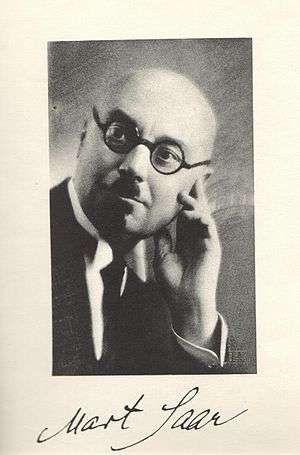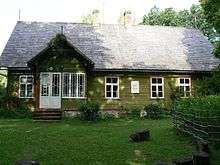Mart Saar
| Mart Saar | |
|---|---|
 | |
| Born |
28 September 1882 Hüpassaare, Viljandi County, Livonian Governorate, Russian Empire |
| Died |
28 October 1963 (aged 81) Tallinn, Estonian SSR, Soviet Union |
| Occupation | Composer, organist, collector of folk songs |
| Years active | 1911-1963 |
| Spouse(s) |
Elise Saar (née Paalmann) Magda Elisabeth Saar (née Takk) |
Mart Saar (28 September [O.S. 15 September] 1882 in Hüpassaare - 28 October 1963 in Tallinn) was an Estonian composer, organist and collector of folk songs.
Childhood

Saar was born at the small borough of Hüpassaare (now in Karjasoo, Suure-Jaani Parish), Viljandi County, Estonia, then part of the Livonian Governorate, Russian Empire, to Mihkel and Ann Saar (née Kimmel). His father was employed in the forestry business. He was the eldest of fours siblings; Anna (1885-1968), Hans (1895-1979) and Jaan (1897-1898). His father was employed in the forestry business. He received his education in the village school at Kaansoo and the Suure-Jaani Parish school. His music teacher in the Suure-Jaani parish school was Joosep Kapp, the father of Artur Kapp, another famous Estonian composer. Additionally, Saar's father was a talented organist, who gave him lessons at home.
Adult life
In 1901, Saar left home to study music at the Saint Petersburg Conservatory. He graduated in 1908 but chose to continue his studies. After graduation in 1911, he became a music teacher in Tartu. Ten years later, in 1921, he moved to Tallinn, Estonia as a freelance composer and organist. He spent his summers in his native borough Hüpassaare.
In August 1915, he married Elise Paalmann. The couple would have two children; a daughter Heli (1917-1975) and a son, Ülo (1927-1945). The marriage would end in divorce when Elise moved to the United States in 1937, initially expecting Saar to join her. However, Saar decided that he didn't wish to leave Estonia. Saar would later marry Magda Elisabeth Takk and have a daughter named Tuuli.[1]
Career
Early in his career, Saar was influenced by the European music of the early 19th century.
Later in his life, Saar combined Estonian folk music with more contemporary sounds. He mixed vocals into his symphonies. In addition to composing, Saar also wrote lyrics to some of his songs. Usually, these lyrics express a love for Estonia and nature. They also address the brevity of life. Saar's lyrics have been compared to the poetry of Anna Haava and Juhan Liiv.
Selected works
Works for a mixed-gender choir include:
- Põhjavaim (Northern Spirit)
- Seitse Sammeldunud Sängi (Seven Moss-Clad Tombs)
- Oh Kodumaa (Oh, My Homeland)
- Mis Sa Nutad, tammekene? (Why Are You Weeping, Oak Tree?)
- Kõver Kuuseke (Crooked Fir)
- Mälestus (A Memory)
- Allik (Wellspring)
Works for an all-male choir include:
- Küll ma Laulaks (I Would Sing)
Works for an all-female choir include:
- Päikesele (To The Sun)
Solo songs include:
- Must Lind (Black Bird)
- Lauliku Talveüksindus (Singer's Winter Loneliness)
Piano music tracks include:
- 20 Rahvaviisi (20 Folk Songs)
- Eesti Süidid (Estonian Suites)
- Prelüüd ja Fuuga G-duur (Prelude and Fugue in G)
- Humoresk (Humoresque)
- Skizze (Preludes)
References
- ↑ Postimees.Helilooja tütar kaalub Hüpassaare maja riigilt tagasiküsimist. 7 August 2002. Retrieved 7 June 2016.